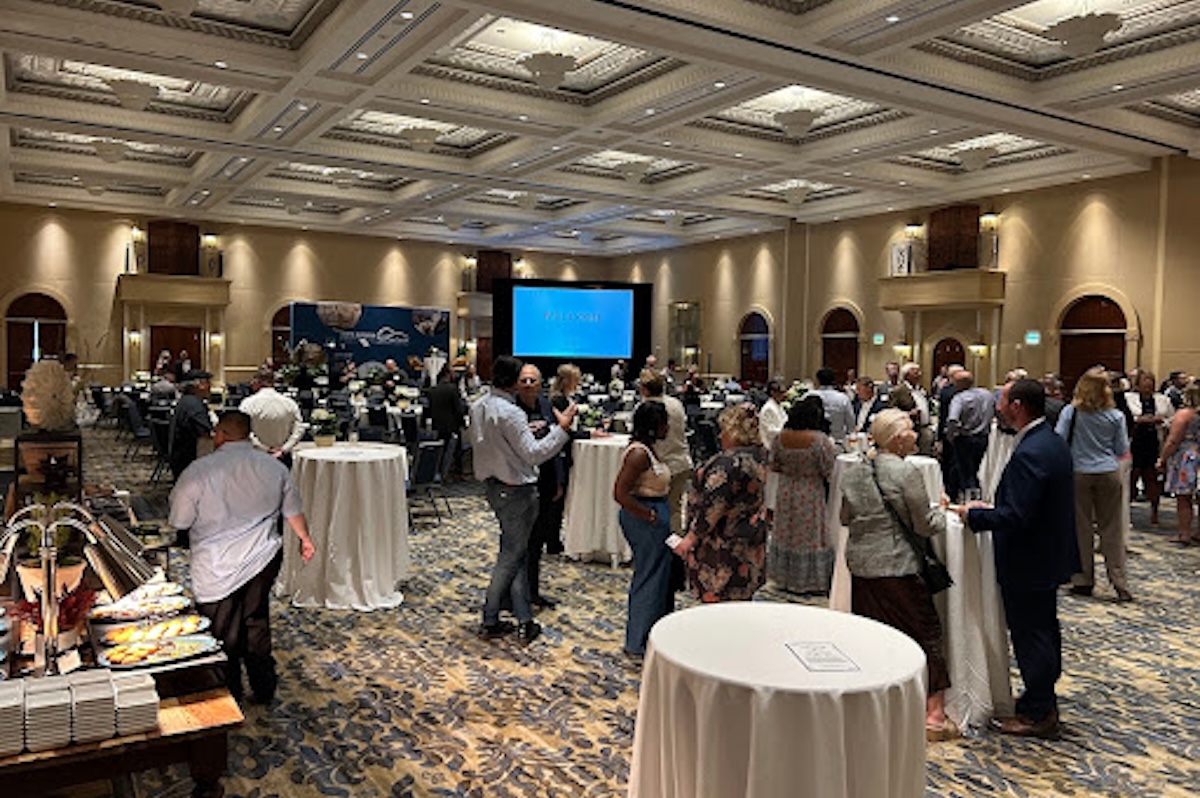Politicians, civil officials, business owners, and other community members mingle at the 2025 State of the County event at the Ritz-Carlton Bacara on August 28. | Credit: Christina McDermott
This article was underwritten in part by the Mickey Flacks Journalism Fund for Social Justice, a proud, innovative supporter of local news. To make a contribution go to sbcan.org/journalism_fund.
Inside a cavernous ballroom at the Ritz-Carlton Bacara, businesspeople, politicians, and civil servants, among others, mingled for Santa Barbara’s fifth-annual State of the County event on Thursday. Put on by the Santa Barbara South Coast Chamber of Commerce, the event focused on Santa Barbara’s economy, business prospects, and local government. Housing — and how to provide more of it — took center stage.
County Executive Officer Mona Miyasato headed up the featured speakers’ talks. She said that only about 5 percent of Santa Barbara County’s physical land is available for urbanization, with large portions of the county either owned by the government or set aside for agriculture.
Most of the county’s population lives in its eight cities. Miyasato said that over the past nine years, the county’s population had declined even as the state’s population has held steady. She said this trend suggested people have migrated out of the county, likely due to housing policies.
“If this continues, it could be a challenge, because many state and federal programs are based on population,” she said.
In the past year, however, the county had grown by 0.6 percent — what Miyasato called an encouraging trend.
Miyasato took time to highlight the county’s push to add housing, saying that the county had approved 460 units of housing in the unincorporated county area, with 7,200 units in the pipeline. Countywide, the state mandates adding about 25,000 units.
First District County Supervisor Roy Lee followed Miyasato. He said families of workers needed an affordable place to live, and employers needed affordable housing so their employees could live where they worked. Lee said the county’s work to streamline projects with affordable units helps save time and money, and was a means to stabilize the local economy.
UC Santa Barbara professor and Economics Forecast Project Director Peter Rupert had a message: build more. He presented data that showed the City of Santa Barbara had increased its housing supply by less than 25 percent since 1970, when the population, according to census data, was about 70,000 people. The county — he said — had fared better, increasing the housing stock by 75 percent. About 264,000 people lived in Santa Barbara County in 1970, according to census data.
Rupert presented prefabricated homes as a means to build affordable housing.
“If you look nationwide, the cost of building manufactured homes is about $90 [per] square foot. You got a curb premium here and stuff like that, but you can buy houses much, much cheaper,” he said.
Second District Supervisor Laura Capps rounded out the speakers with a “fireside chat.” During this conversation, Capps called affordable housing the county’s number one crisis and said that the government should look at the land it owns, including infill developments like parking lots, and building more units.
“The county, it turns out, has about 6,000 acres of underutilized land that I believe passionately should be turned into affordable housing,” she said.
The State of the County also included discussions of job growth and wages. Lure Digital, a video marketing agency, presented a video on Techtopia, positioning Santa Barbara as a place where the tech industry could grow and provide more jobs, especially in the artificial intelligence field. What, specifically, these jobs would be and how much they would pay was not discussed.
Later came talk of farm wages. Economist Peter Rupert talked about the push to raise farmworker’s minimum wage to $26 an hour. Last year, farmworkers and organizers requested the county create an ordinance to set farmworker pay at $26 an hour, citing struggles to pay for food and housing while doing hard manual labor, sometimes in extreme heat or alongside pesticides.
Rupert presented research from a colleague at Arizona State University that said, given the costs and market competition from nearby counties, several produce crops would no longer be grown in Santa Barbara County if labor was paid at that wage.
The event closed with a video from Girls Inc., wherein local girls said what they would change in the county if they had the power to do so. Early in the video, one girl said, “climate change.”
While Supervisor Lee talked about wildfire safety measures, no speaker discussed climate change or its impacts on the economy at length at the event.



